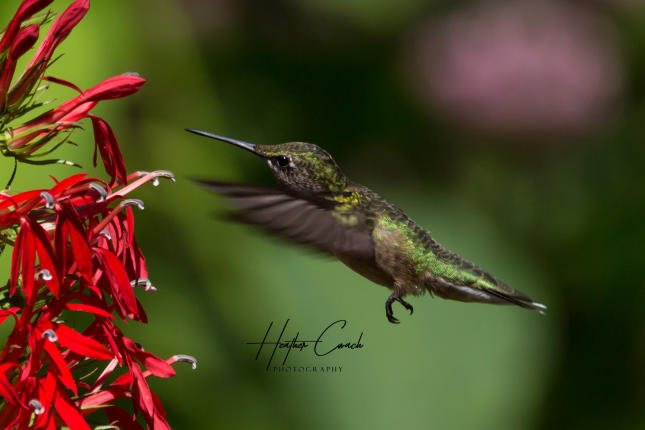How to Attract Hummingbirds with Flowers and Water Features

For hummingbirds to thrive in your yard they require the same things as the other birds do. Food, Shelter and Water.
Food and water seem obvious, but shelter and protection are also essential to attracting these flying gems. Dense foliage of trees provides not only protection, but also a source of the insects and protein they provide. This is also why is is important to minimize or eliminate the use of pesticides that would kill the insects they and other birds eat though out your yard. Trees, large shrubs and especially bare branches provide perches or resting places between meals at the feeders or flowers. They also provides lookouts for hummingbirds as they aggressively defend their territories.
Hummingbirds can be easily drawn to nectar feeders, but their primary diet consists of nectar from flowers, small insects, and sometimes even pollen and sap. They feed in many small meals, consuming small insects and up to twelve times their own body weight in nectar each day. They must eat once every 10-15 minutes and visit between 1,000 and 2,000 flowers per day. Many plant species rely on hummingbirds for pollination and provide nectar and tiny insects in exchange. Favorite flowers are often red in color, and tubular in shape. Although they show a slight preference for red. orange,and bright pink tubular flowers, there are many others they feed on just as readily. Hummingbirds feed from both native and non-native varieties. The best natural food source gardens supplement with a variety of flowers that provide a succession of staggered bloom through the seasons. Find native plants at audobon.org.
Hummingbirds enjoy a cool dip on a hot day, and will frequently splash in shallow bird baths or fountains. They particularly enjoy water with movement, like gently moving water or mist and will frequently be found spritzing in the sprinklers or fine misting device.
The best way to encourage these tiny birds to remain in your yard is to grow a diversity of nectar-producing flowers they prefer and have feeders as a supplement especially when blooms are scarce. Flowers don't have to be planted just in the garden, as hummingbirds will readily visit flowers in containers too. Once hummingbirds discover a patch of flowers, they are likely to continue visiting throughout the season and will usually return the following year.
Favorite plants for Midwest Hummingbird Gardens (not necessarily natives)
Those denoted with asterisks are considered by many to be the very best hummingbird plants to grow in the Midwest.
- Agostache rupestris Threadleaf Giant Hyssop
- Aquilegia canadensis Eastern Red Columbine
- Asclepias species Milkweed Species--primarily Common Milkweed (syriaca) and Bloodflower (currasavica) but also others
- Buddleia davidii Butterfly Bush
- Campsis radicans Trumpet Vine
- Canna indica Canna
- Cleome hassleriana Spider Flower
- *Cuphea species including schumanii, llavea and hybrids, esp. 'David Verity'
- Delphinium exaltatum Perennial Larkspur
- Digitalis grandiflora Yellow Foxglove
- Digitalis x mertonensis Strawberry Foxglove
- Digitalis purpurea Common Foxglove
- Fuchsia triphylla 'Gartenmeister'
- Heuchera sanquinea Coral Bells
- Hibiscus syriacus Rose of Sharon
- Hosta
- Impatiens capensis Jewelweed (red only)
- Ipomoea coccinea Red Morning Glory
- Ipomoea sloteri Cardinal Climber
- Ipomopsis rubra Spanish Larkspur
- Justicia brandegeana Shrimp Plant
- Kniphofia uvaria Red Hot Poker
- Lantana camara and hybrids, especially red ones
- *Lobelia cardinalis Cardinal Flower
- Lobelia siphilitica Great Blue Lobelia
- *Lonicera sempervirens Coral Honeysuckle
- *Monarda didyma Bee Balm
- Nepeta spp. Catmint
- Penstemon spp. Penstemon
- Phaseolus coccineus Scarlet Runner Bean
- Phlox paniculata (tall garden types)
- Salvia azurea
- *Salvia coccinea Texas or Scarlet Sage
- Salvia exserta Bolivian Sage
- Salvia greggi 'Hot Lips', 'Navojo Red' and others
- *Salvia guaranitica Blue Anise Sage
- Salvia splendens
- Salvia hybrids 'Indigo Spires', 'Phyllis Fancy', 'Purple Majesty'
- Tithonia rotundifolia Mexican Sunflower
- Verbena spp and hybrids
- Weigela florida
- Zinnia elegans

